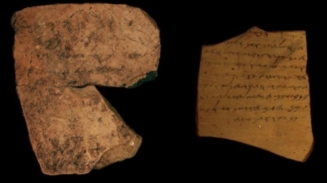
2600年前的约旦人普遍识字
Find Shows Widespread Literacy 2,600 Years Ago in Judah
2600年前的约旦人普遍识字
Mundane notes about daily life on 16 ceramic shards written about 600 B.C. at an ancient military fortress in the Negev Desert reveal that literacy had to be common.
在内盖夫沙漠(Negev Desert)中的古代军事堡垒发现的16片陶瓷碎片上以笔记的形式记载了大概公元前600年时的世俗生活,揭露了那时候的古人普遍识字。
播音/撰文 辛西娅·盖博 (Cynthia Graber)
翻译 Meatle
审校 邰伦玥
The Hebrew bible was first written down some 2,600 years ago. And scholars have argued that only a population with sufficiently widespread literacy could have accomplished the task. Now there’s new evidence for such literacy—in the form of notes from that same time period, written in ink on shards of pottery.
希伯来圣经(Hebrew bible)在2600年前成书。学者辩称只有当时的居民广泛识字才有可能完成这样的创举。现在,我们发现了支持这种识字学说的新证据——来自同一时代用墨汁书写在陶片上的笔记。
Scientists have debated whether the first significant phase of the compilation of biblical texts happened before or after the fall of the first Temple, in 586 B.C. To get at the potential answers to that question, a group of researchers in Israel analyzed mundane inscriptions about the needs of daily life on 16 ceramic shards written about 600 B.C. from an ancient military fortress in Arad, at the northern edge of the Negev desert. These notes had no direct connection with biblical texts, which were more frequently written on papyrus or parchment and would not have survived the region’s climate. But they reveal that literacy did not belong to a privileged few. The study is in theProceedings of the National Academy of Sciences. [Shira Faigenbaum-Golovin et al, Algorithmic handwriting analysis of Judah’s military correspondence sheds light on composition of biblical texts]
学界一直在争论希伯来圣经的首次编撰是在第一圣殿的破坏之前还是之后,即在公元前586年前还是后。(译者按:第一圣殿是指在公元前957年落成的位于耶路撒冷的第一所罗门神殿,其在公元前586年被巴比伦人完全破坏。参考)为了寻找可能的答案,一队来自以色列的研究人员分析了16枚书写于公元前600年的陶片上的世俗笔记。这些陶片在内盖夫沙漠边缘的阿拉德的一个军事堡垒中被发现了。这些笔记与圣经文本没有直接的联系,而圣经的文本往往被书写于无法在该地的气候下保存下来的莎草纸与羊皮纸之上。这些笔记并不来源于特权阶级。该项发现发表在《美国国家科学院学报》上(Proceedings of the National Academy of Sciences)。
The research team was able to determine that the documents—detailing military movements and food expenses—were written by a minimum of six authors. The scientists could even generally identify those authors, who ranged from a military commander down the ranks to a much lower subordinate.
研究团队确认,这些文件记载了详尽的军事行动和食物消耗,这些资料至少由6名作者写就。研究人员甚至能够识别出这些作者的身份,他们上至将军,下至底层军事人员。
"This means that not only their priests were able to write, but also the an army administration were literate down to the quartermaster of this fort in the desert.” Shira Faigenbaum-Golovin, a Tel Aviv University researcher involved with the study. “This indicates that in Judah, in the sixth century, there were high literacy ranks in not only the elite people but among simple people also.”
Such widespread literacy in the region could have set the stage for the eventual compilation of the Bible, and thus the foundation of the monotheism that still prevails in the West.
“这意味着不仅他们的神职人员能够写作,而且即使是底层的军事管理人员,比如在这个沙漠堡垒中的军需官,也能够识字写字。”以色列的特维拉夫大学(Tel Aviv University)的研究人员,席拉·费更巴姆-戈洛文(Shira Faigenbaum-Golovin)说。“这意味着,在公元前6世纪的约旦,不单单在精英阶层,在普通人种也有相当的识字率。”
未经书面许可任何人不得复制或镜像
京ICP备11000850号-1
 京公网安备11010502039775号
京公网安备11010502039775号 信息网络传播视听节目许可证0111611号
国家科技基础条件平台

















